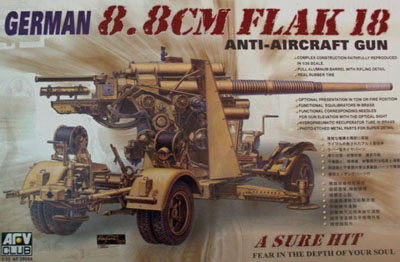AFV Club German 8.8 cm Flak 18
Anti-Aircraft Gun (AF 35088)
by Cookie Sewell

388 parts (350 in olive drab styrene, 25 etched brass,
6 tires in black vinyl, 3 brass tubes, 2 sections of brass chain, 1 turned
aluminum barrel, 1 roll of clear vinyl tubing); price not known but estimated
at US $35.98
Advantages: first kit of this gun in this scale; nicely
done job on the Sd.Anh. 201 bogies; operating balancing cylinders on gun
mount
Disadvantages: extremely tiny parts may frustrate some modelers; does
not have all of the options of the DML kit, such as optional barrel
Rating: Highly Recommended
Recommendation: to all WW II German fans and "Duck Hunters"
(ADA fans)
After over 30 years with only one "88" kit on
the market, in a matter of weeks two kits have been released to cover
the gamut – DML's Flak 36/37 and AFV Club's Flak 18. While the guns
were ballistically identical, used the same ammunition, and even had a
large number of interchangeable parts, the older Flak 18 always struck
me more as the "sports model" of the gun due to the lighter
appearance of its Sd. Anh. 201 bogie assemblies.
The Flak 18 was the first version of the new 8.8 cm antiaircraft
gun to be produced, and entered production in time to see service in Spain.
It was not until later on that the fear of having many antitank guns outmatched
by enemy armor protection caused designers to look into armor-piercing
rounds for the weapon. (The great advantage that permits an AA gun to
be converted to an antitank gun is the fact it needs high muzzle velocity
to sling a shell up to a useful altitude to engage aircraft; that is what
permits it to fire a relatively heavy AP round at sufficient velocity
to defeat armor.)
The Flak 18 received a splinter shield and direct fire sights
after Spain, and was used from then on as a dual purpose weapon. Many
18s were rebuilt at some point in their careers with improved Flak 36
components. The gun on display at APG's Ordnance Museum is a Flak 18 that
was upgraded in 1942 with a Flak 36 barrel and twin fuse setters, and
which was captured in Tunisia in 1943. This gun was highlighted in the
captured material manual on the weapon (TM E9-369A dated 29 June 1943).
The kit is a good replica of a slightly upgraded Flak 18
that has been optimized for antiaircraft work as well as antitank work.
It has twin fuse setters (the APG one had twin bays but only one setter
in its device) and some minor tweaks. The kit only provides the Flak 18
barrel (albeit as an excellent one-piece turned item) so cannot be fully
upgraded without a swap. (As an aside, note that APG's Flak 36 was delivered
with a Flak 18 barrel. Go figure.)
The kit is about as complex as the DML one so modelers will
be happy to learn you don't have to choose one over the other unless you
prefer either the 18 or 36; I suspect many will want both. The reason
for the difference in parts (388 versus 609) is mostly due to the lack
of a crew and a plethora of accessories such as ammo crates and spare
rounds.
The kit comes in olive drab, which is an odd choice that
AFV Club has selected for some time now to mold their German kits. It's
a bit more difficult to cover with paint than the more common DML primer
grey styrene or tans as used by Academy and Tamiya, so I have no idea
why they choose to use this color for all current kits. Five sprues are
new and one is a carryover from the older le FH 18 10.5 cm kit (tools
and some sight parts.) All parts are crisply molded in the AFV Club style.
The model offers options, but they are either A or B and
no in-betweens. For example, the gun can be either displayed in firing
position or march order, but cannot convert from one to the other. Also
the shield can be mounted or left off. The gun, however, can be traversed
and elevated in firing position, and comes with working elevation balance
cylinders (they use a brass sleeve for compensating for the change in
length; DML and Tamiya used separate sets for "down" and "up.")
The directions are among the better sets from AFV Club and
are actually easy to read, with colors flagged for detail painting vice
obscure numbers keyed to the manufacturer's favorite brand of paint. Incidentally,
there is a small error in the blurb on the front of the sheet that claims
the Flak 18 had no brakes. The Flak 18 did have service and parking brakes,
to be sure (the drums for the single wheels are not what one could call
subtle!) What it did not have was a lockout for the suspension that would
permit it to be fired from march order without a lot of problems.
Marking and painting instructions are included for six
different weapons, but are rather generic and somebody wasn't thinking
too clearly on reuse. The kit comes with "kill rings" in both
black and white, but one set has obvious Eastern Front rings as they note
tanks and river barges; this is also listed for one in North Africa! I
suggest looking for photos of specific guns.
Overall this is a nice kit and should prove popular, and
for once AFV Club did not go head-on-head with DML on a specific weapon.
Thanks to Miin Herng Tsueng of AFV Club for the review sample.
|